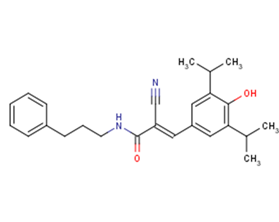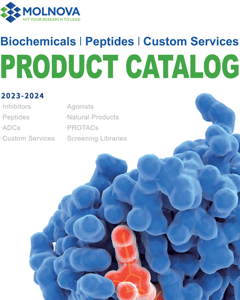
Su1498
CAS No. 168835-82-3
Su1498( SU-1498 | SU 1498 | SU1498 | Tyrphostin SU 1498 )
Catalog No. M17363 CAS No. 168835-82-3
SU 1498 is a selective inhibitor of the receptor tyrosine kinase VEGF receptor 2 (VEGFR2, aka FLK1; IC50 = 700 nM).
Purity : >98% (HPLC)
 COA
COA
 Datasheet
Datasheet
 HNMR
HNMR
 HPLC
HPLC
 MSDS
MSDS
 Handing Instructions
Handing Instructions
| Size | Price / USD | Stock | Quantity |
| 2MG | 42 | In Stock |


|
| 5MG | 65 | In Stock |


|
| 10MG | 110 | In Stock |


|
| 25MG | 210 | In Stock |


|
| 50MG | 311 | In Stock |


|
| 100MG | 462 | In Stock |


|
| 200MG | Get Quote | In Stock |


|
| 500MG | Get Quote | In Stock |


|
| 1G | Get Quote | In Stock |


|
Biological Information
-
Product NameSu1498
-
NoteResearch use only, not for human use.
-
Brief DescriptionSU 1498 is a selective inhibitor of the receptor tyrosine kinase VEGF receptor 2 (VEGFR2, aka FLK1; IC50 = 700 nM).
-
DescriptionSU 1498 is a selective inhibitor of the receptor tyrosine kinase VEGF receptor 2 (VEGFR2, aka FLK1; IC50 = 700 nM), having negligible activity at several other serine/threonine and tyrosine kinases.1, 2 It effectively blocks signaling through VEGFR2 both in vitro and in vivo.1, 3 SU 1498 is used to study the role of VEGFR2 signaling in diverse processes, including angiogenesis, tumor growth, neural progenitor cell survival, and neuroregeneration.
-
In VitroSU1498 stimulates accumulation of phosphorylated ERKs in human umbilical vein endothelial cells and in human aortic endothelial cells in a manner that is dependent on the functioning of the upstream components of the MAPK pathway, B-Raf, and MEK kinases. The enhanced accumulation of phospho-ERKs is observed only in cells that have been stimulated with sphingosine 1-phosphate or protein growth factors; SU1498 by itself is ineffective. SU1498 blocks signal transduction from VEGFR2 in MS1 VEGF cells.In the presence of SU1498, levels of Ets-1 are decreased, suggesting that VEGF-VEGFR-2 interactions contributed to baseline levels of Ets-1 expression, and interruption of this autocrine interaction with SU1498 led to decreased expression of Ets-1. SU1498 treatment significantly impacts U87 cell proliferation and apoptosis. SU1498 induces a marked increase in lipids and a decrease in glycerophosphocholine. Accordingly, accumulation of lipid droplets is seen in the cytoplasm of SU1498-treated U87 cells.
-
In Vivo——
-
SynonymsSU-1498 | SU 1498 | SU1498 | Tyrphostin SU 1498
-
PathwayOthers
-
TargetOther Targets
-
RecptorVEGFR2
-
Research Area——
-
Indication——
Chemical Information
-
CAS Number168835-82-3
-
Formula Weight390.53
-
Molecular FormulaC25H30N2O2
-
Purity>98% (HPLC)
-
SolubilityDMSO : ≥ 150 mg/mL. 384.10 mM
-
SMILESO=C(/C(=C/c1cc(C(C)C)c(O)c(C(C)C)c1)/C#N)NCCCc1ccccc1
-
Chemical Name(2E)-2-cyano-3-[4-hydroxy-3,5-bis(1-methylethyl)phenyl]-N-(3-phenylpropyl)-2-propenamide
Shipping & Storage Information
-
Storage(-20℃)
-
ShippingWith Ice Pack
-
Stability≥ 2 years
Reference
1: Gawlak G, et al.Am J Physiol Lung Cell Mol Physiol. 2016 Jun 1;310(11):L1062-70.
molnova catalog



related products
-
Isoscabertopin
Isoscabertopin has anticancer activity.
-
Tiaramide hydrochlor...
Tiaramide hydrochloride is an anti-inflammatory drug that inhibits the action of mediators released from mast cells and has direct smooth muscle relaxant properties.
-
Aficamten
Aficamten is a Next-Generation Cardiac Myosin Inhibitor for the Treatment of Hypertrophic Cardiomyopathy.



 Cart
Cart
 sales@molnova.com
sales@molnova.com


